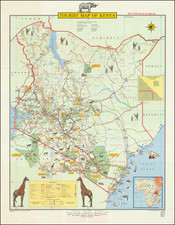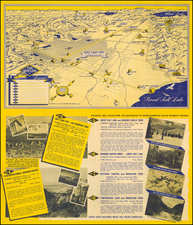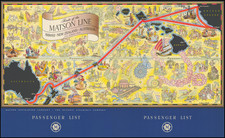Detailed map of famed Southern California amusement park Knotts Berry Farm in its early days.
Knotts Berry Farm
The Knott's Berry Farm originated from a berry farm owned by Walter Knott (1889–1981). In the 1920s, Knott and his wife, Cordelia, sold berries, berry preserves and pies from a roadside stand beside State Route 39, near the small town of Buena Park.
In 1934, to make ends meet, Knott's wife Cordelia (1890–1974) began serving fried chicken dinners on their wedding china. For dessert, Knott's signature Boysenberry Pie was also served to guests dining in the small tea room. As Southern California developed, Highway 39 became the major north-south connection between Los Angeles County and the beaches of Orange County, and the restaurant's location was a popular stopping point for drivers making the two-hour trip in those days before freeways.
As time went on, more shops and interactive displays were opened to entertain patrons waiting for a seat at the Chicken Dinner Restaurant. The Berry Market expanded South from Mrs. Knott's Chicken Dinner Restaurant along Grand Ave. with the addition of wishing wells, rock gardens, with miniature waterfalls, water wheels and a grindstone "Down by the Old Mill Stream", near a replica of George Washington's Mount Vernon fireplace, Lost and Found, Nursery, Preserving Kitchen and Administration Offices.
Before long, the Knotts had added Virginia's Gift Shop and several more shops and attractions such as a 15-million-year-old petrified log, a thirteen-foot diameter cross section of coastal redwood cut at age 750 years, a visible bee-hive and an oxcart, with several wagons provided additional photo opportunities. The entire operation would soon be renamed Knott's Berry Place.
Walt built a 12-foot-tall volcano of lava rock trucked in from the Pisgah Crater in the Mojave Desert and equipped it with a boiler that rumbled, hissed, and spit steam at the push of a button. From the West side of the volcano, guests could enter a mine shaft following a vein of gold down into a large open pit and the Pan-for-Gold activity where customers could buy a ticket to pan for real gold to take home in a vial. Nearby the gold mine shaft entrance, the prospectors mule would haul a stone around an Arrastra, a circular ore grinding pit, filled with gold bearing quartz to release its gold.
Walter add the Ghost Town in the 1940s and 1950s.













![[Kensington Metropolitan Park / Kent Lake] Scouting To Adventure Gold Rush of '48 Detroit Area Council Boy Scouts of America . . . 1948](https://storage.googleapis.com/raremaps/img/small/63032.jpg)
![(Pacific Coast Exploration) Relacion del viage hecho por las goletas Sutil y Mexicana en el año de 1792 para reconocer el Estrecho de Fuca: con una introduccion en que se da noticia de las expediciones executadas anteriormente por los españoles en busca del paso del noroeste de la América. [Account of the voyage undertaken by the schooners Sutil and Mexicana in the year 1792 to explore the Strait of Juan de Fuca: with an introduction that provides information about the expeditions previously carried out by the Spaniards in search of the Northwest Passage of America.]](https://storage.googleapis.com/raremaps/img/small/94653.jpg)

